Forest Succession in the Adirondacks
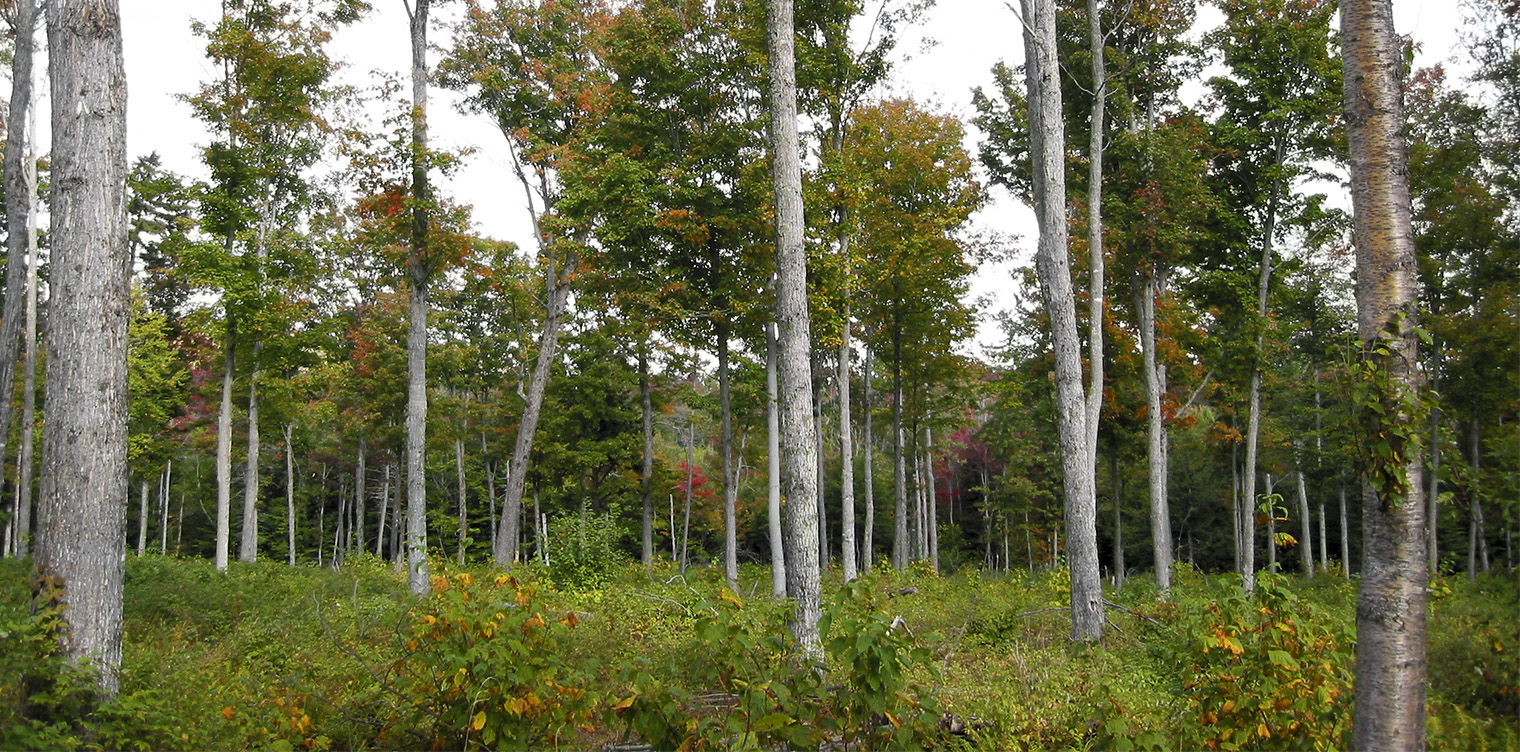
Adirondack habitats, like all habitats, are constantly changing in reaction to environmental disturbances – a process referred to as ecological succession. The plants and wildlife (as well as the sights, sounds, and smells) of a particular Adirondack forest provide a snapshot in time, a single instance in a lengthy and ongoing process through which the forest adapts to disturbances in its environment.
From a longterm perspective, every square inch of the Adirondack Park is affected by succession. Even those limited areas untouched by logging, mining, agriculture, and development reflect the process of adapting to the changed environment left by the retreating glaciers which sculpted the Adirondack Mountains. The focus here, however, is on short-term disturbances – events which have taken place over the last century or so.
Forest Disturbances and Adirondack Forests
How forests, and the creatures who dwell within them, recover and adapt to disturbance depends on a lengthy list of variables:
- What was there before the disturbance? Was the area being used for agriculture? Was the area forested? What kind of forests existed before the disturbance? Localized factors (including elevation, terrain, soil, and water table) are also important in understanding how the habitat responds to disturbance.
- What was the nature of the disturbance? The impact of a forest disturbance depends on what it involved and how long it lasted. Old field succession – the process by which plants and animals re-colonize abandoned farmland – produces a different response, and a different environment, than forest succession in woodlands recovering from fire. Fire recovery, in turn, depends on the extent and intensity of the fire. Similarly, the habitat that emerges in a forest recovering from logging depends on the nature of the logging operation: what kind of equipment was used, what kind of logging took place (for instance, clear cutting vs single tree selection), what trees were removed, and how large an area was affected. The impact of weather events, such as blowdowns and ice storms, depends in part on the intensity of the storm or flood and how much acreage was affected.
- What has happened since? How many years have passed since the disturbance? What intervening disturbances and developments have occurred? Was the disturbed area allowed to revegetate naturally or was it reforested as part of the New York State's reforestation programs in the 1920s and 30s? Moreover, virtually all forest environments in the Adirondacks (including those lands responding to more localized disturbances, such as logging, farming, fire, and weather events) are reacting to the ongoing impact of acid rain and climate change.
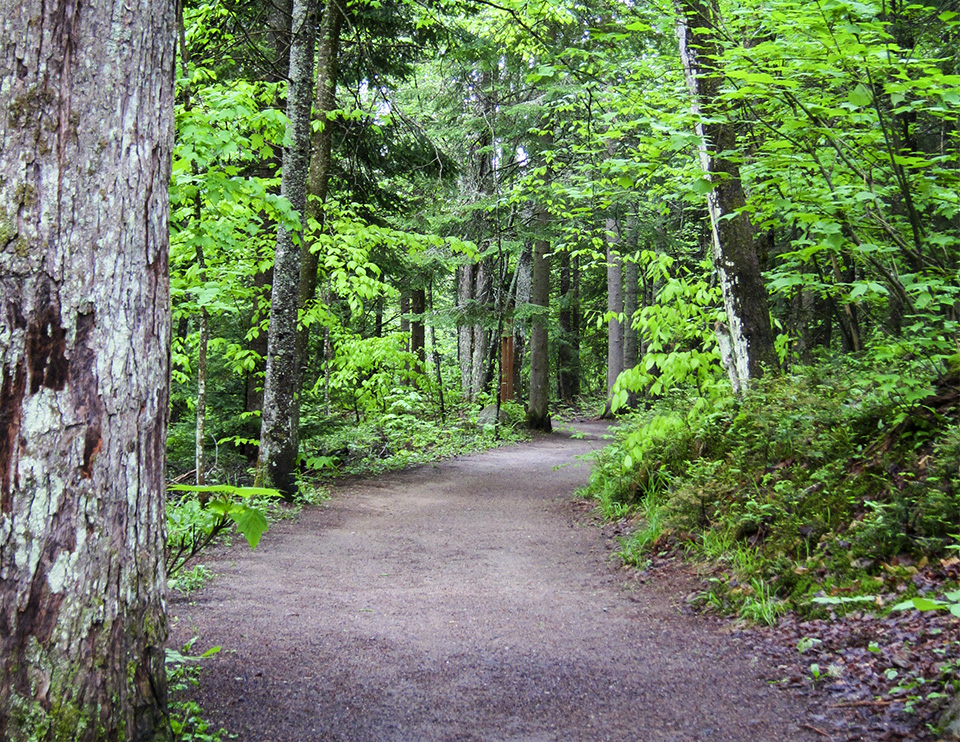
The process of ecological succession in the Adirondack Mountains usually begins with pioneer plant communities consisting of shade-intolerant species requiring full sun. Profiting from the lack of competition from more shade-tolerant species, these pioneer plants are able to colonize the disturbed environment. As this process unfolds, the changing ecosystem attracts wildlife equipped to flourish in an early successional forest and shrub habitat.
As they grow, the pioneers create a more shady environment unsuitable for their own seedlings. They are unable to compete with more shade-tolerant species. These more shade-tolerant plants gradually become established in the understory and out-compete the original pioneer species. The mid-tolerant plants which had replaced the initial pioneers, in turn, yield to species able to grow in dense shade.
Eventually a relatively stable mix of long-lived, shade-tolerant trees develops. This mature forest is sometimes referred to as a climax community. It is important to remember, however, that mature forests are themselves continuing to respond and adapt to ongoing disturbances in their environment, both natural and manmade.
Old Field Succession in the Adirondacks
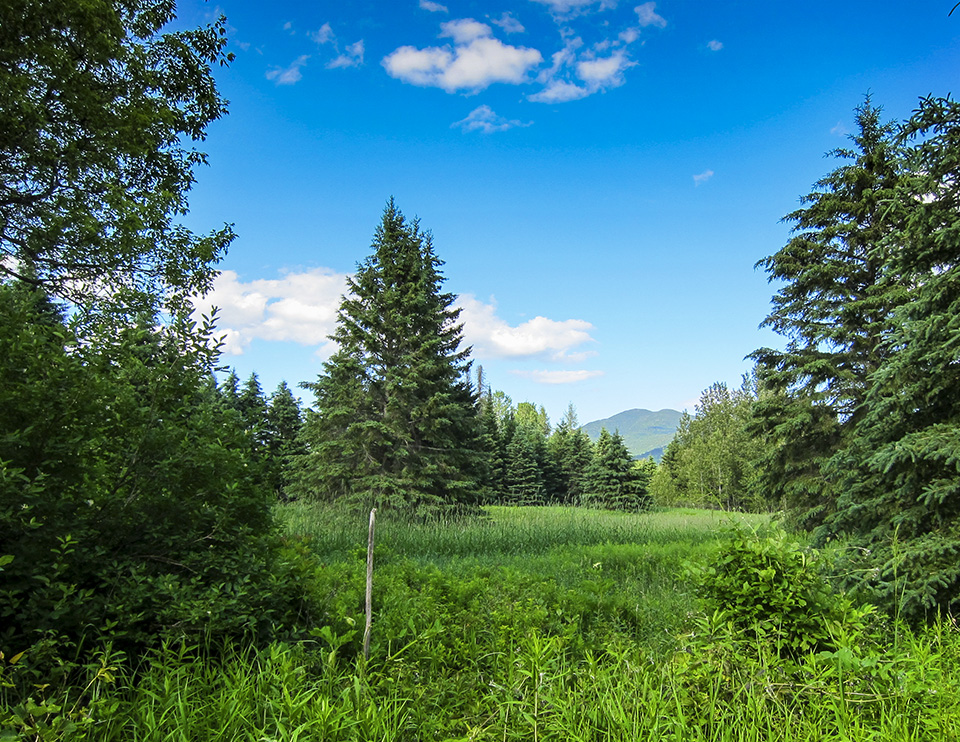
Exploring abandoned farmland in the Adirondacks provides a fascinating glimpse into how plants and animals adapt to changing environments. Limited areas in the Adirondack Park were cleared for farming; most has been abandoned. In some cases, the forest that replaced the abandoned farmland is the result of a massive tree planting program spearheaded by the New York State Conservation Department in the 1920s and 30s. These efforts produced the dreary plantations of Red Pine and Scotch Pine seen along some Adirondack roadways and now approaching the end of their biological life.
In other cases, the land has been allowed to revegetate naturally.
- The earliest pioneer species that move in when a pasture or agricultural field is allowed to revegetate naturally are grasses and herbaceous plants such as ragweed, asters, and goldenrod. The mix includes both native species and alien annuals, such as Common Stitchwort and Chickweed. These shade-intolerant plants (both native and nonnative) are able to move in quickly because their seeds were present in the soil and because they can capitalize on full sunlight.
- Early pioneering shrubs and trees usually follow. Shrubs such as Meadowsweet can often be found in fields abandoned a decade or more. Among the most important of the shrubs which colonize abandoned fields are members of the heath family, such as Lowbush Blueberry.
- The trees which initially move into the disturbed areas tend to be hardy, but short-lived, plants that are able to colonize nutrient-poor sites. Common trees found in abandoned fields include Quaking Aspens, Choke Cherry, and Pin Cherry. Most of these pioneer, or early succession, trees are short-lived and shade-intolerant. An example is the Pin Cherry, a fast-growing, shade-intolerant deciduous tree which lives only 25 to 30 years. An exception is the Eastern White Pine, which is a common invader of old fields, particularly on the eastern side of the Adirondacks, and can live 300 to 350 years.
- These early colonizers provide shade that moderates soil temperatures and helps develop a seed bed suitable for more shade-tolerant species, such as Yellow Birch, which will probably, in turn, be crowded out by the two most shade-tolerant hardwoods: Sugar Maple and American Beech.
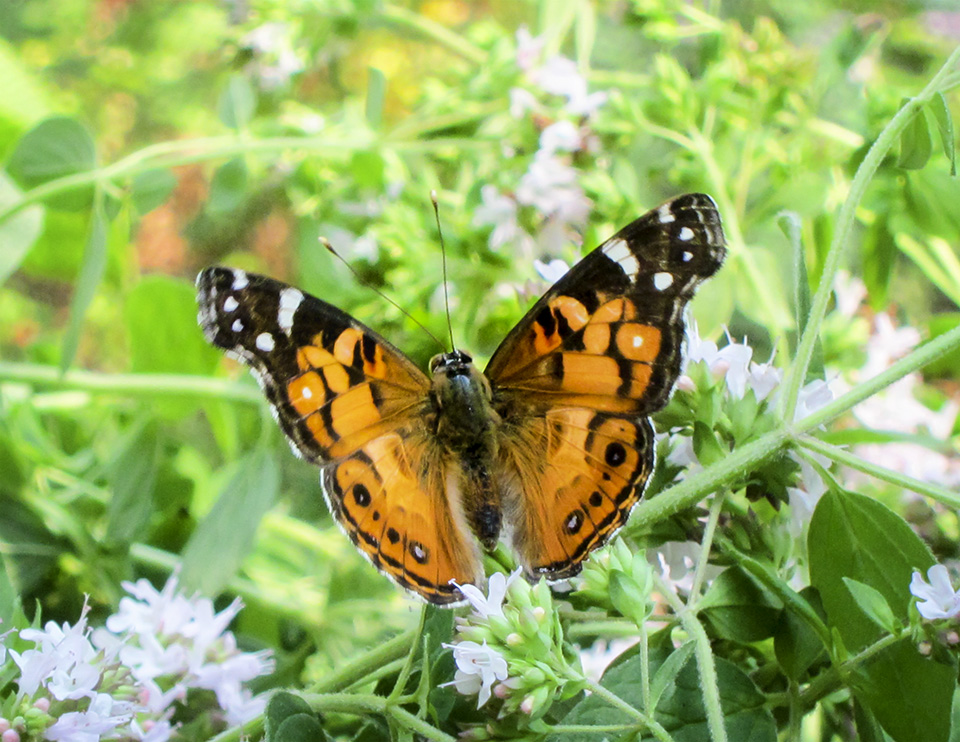
In the interim, the habitat created on abandoned fields attracts a wide variety of birds, mammals, and insects whose nutrition, breeding, and cover requirements are met. For instance, the wildflowers that populate early successional field attract those butterflies that require these species as host plants for breeding or as a source of nectar. Examples include Clouded Sulphur, American Lady, Red Admiral, Monarch, Great Spangled Fritillary, and Common Ringlet.
The mix of wildlife found on old fields varies with the mix of plants found on the site. This, in turn, depends on the length of time since the field was abandoned, as well as localized features, such as soil, terrain, drainage, and elevation.
Some old-field dwellers are generalists who are found in other habitats as well. Others have more exacting requirements and will gradually disappear as the old field evolves toward a mature forest.
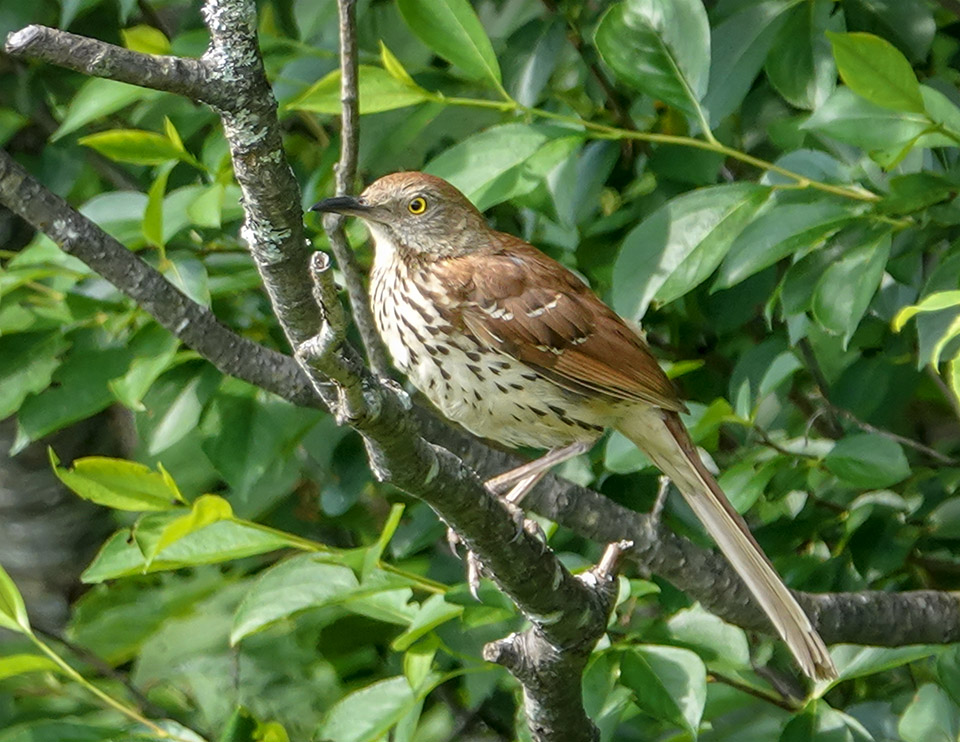
Birds common in old fields include the Brown Thrasher, which reaches its highest densities in shrub or mid-successional stages of forests.
- The Brown Thrasher is a seasonal resident of the Adirondacks, nesting in May and June. It makes its nest on the ground or in low shrubs; the nest is loosely constructed of trees and grasses.
- A remarkable singer with one of the largest repertoires of any North American passerine, it is less often seen than heard, because of its tendency to forage on the ground and skulk in dense brush when disturbed.
- Brown Thrasher breeding populations in New York State and particularly in the Adirondacks declined significantly between the 1980-1985 New York Breeding Bird Survey and the 2000-2005 survey, probably because of habitat loss as the shrubby fields this species favors matured into older forests.
Another bird to look for in old fields is the Indigo Bunting, another seasonal resident. These striking, sparrow-sized birds prefer brushy areas such as roadsides, abandoned pastures, and power-line right-of-ways. Although abundant in eastern North America and frequently seen in other parts of New York State, Indigo Buntings are less common in the Adirondacks, because many of the abandoned fields they prefer have already developed into mature forests.
Several of the warbler species that summer in the Adirondacks also prefer old fields and young forests. These include American Redstarts, Chestnut-sided Warblers, and Mourning Warblers. The Chestnut-sided Warbler, for example, is an early successional species usually found in brushy thickets, bushy pastures, forest openings, the edges of forests, and neglected roadsides. They generally avoid conifer-dominated habitats, mature deciduous forests, areas of intense agriculture, and developed areas in towns and cities.
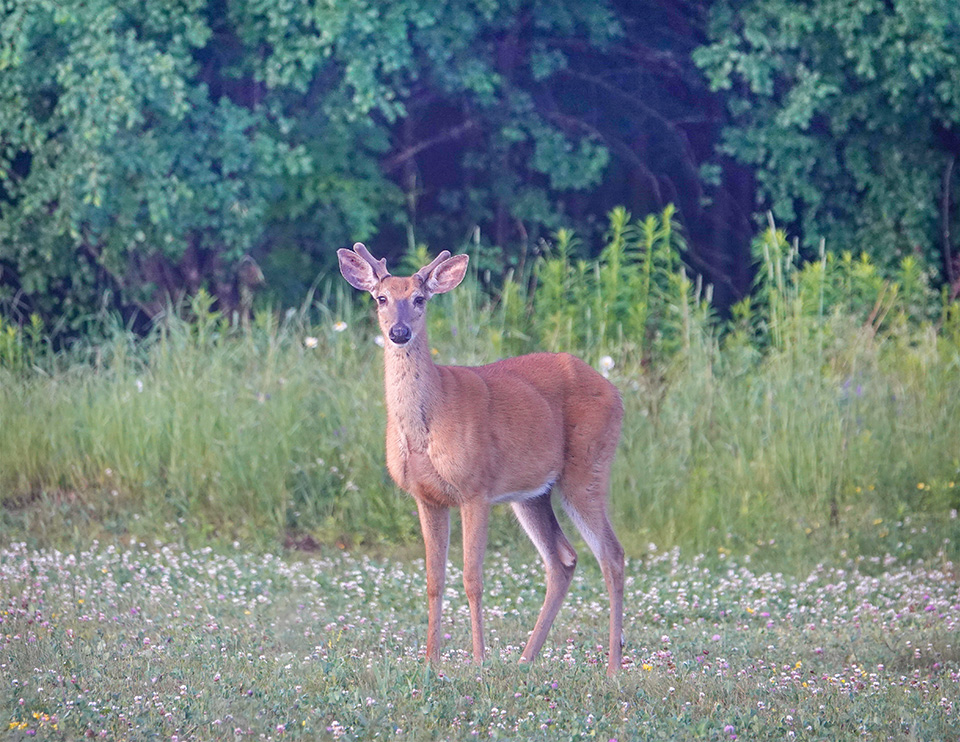
Mammals which may be found in old fields include prey animals such as White-tailed Deer, White-footed Mice, Meadow Voles, Meadow Jumping Mice, and Woodchucks. These creatures, in turn, attract predators such as Eastern Coyotes, Red Foxes, and Bobcats.
The link between predator and prey is illustrated by Eastern Coyotes and White-tailed Deer. Coyotes (known for their characteristic howls) can occupy virtually any habitat and make a living consuming birds, reptiles, insects, and fruit. These wolf-like canids are now the most dominant carnivore in the Adirondack Park. Coyotes seem to prefer brushy areas, perhaps because an important winter food source – the White-tailed Deer – is often found in this habitat.
The White-tailed Deer was uncommon in the Adirondacks up to the middle of the 19th century. It now resides in all terrestrial communities in the Adirondack, but is generally more numerous on the Park's periphery. This reflects the availability of the white-tail's preferred habit, which includes brushy fields, wooded farmlands, and early successional forests, all of which are more abundant in the foothills.
Forest Succession after Adirondack Logging Operations
Much of the Adirondack forest is second-growth forest: the woodlands which have grown up after logging operations. Much of the logging, particularly clearcut logging, took place in the late 19th and early 20th centuries, so much of this land has already developed or is developing into mature forests. How these forests recovered and what the recovering forests look like today depends on what the loggers started with, which trees were removed, and whether other major disturbances (such as fire) followed the logging.
In general, the forests that emerged in the wake of these earlier logging operations reflected a shift away from mixtures of spruce and hemlock and toward a forest with more hardwoods. It is difficult to disentangle the extent to which this trend reflects the intense logging of a century ago or the post-logging fires which followed in many areas.
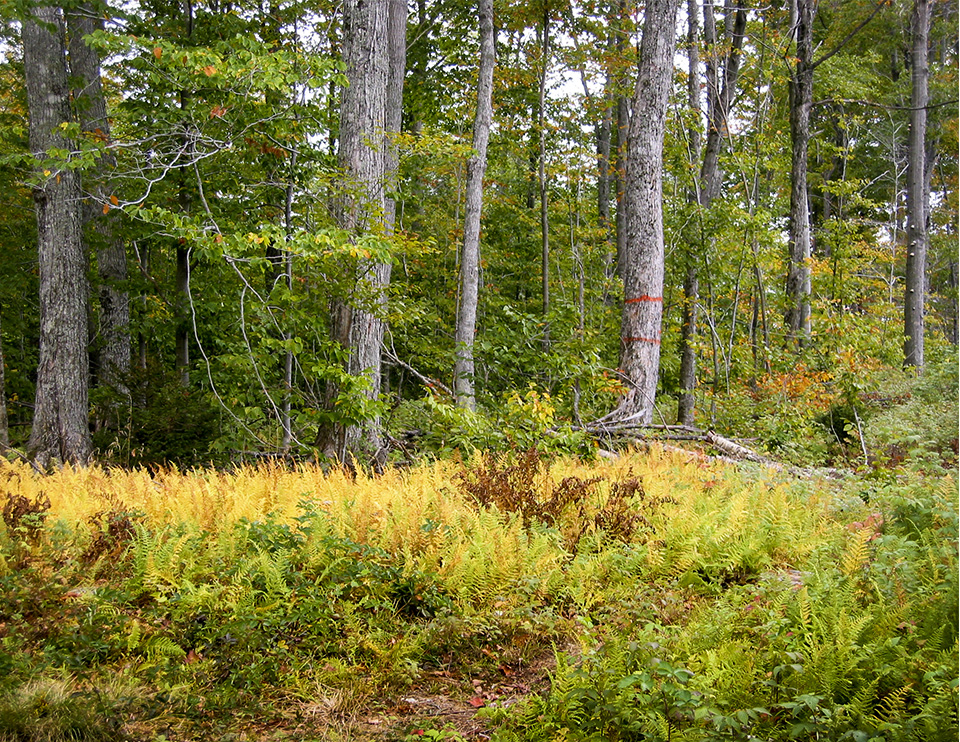
Forest Ecosystem Research and Demonstration Area (FERDA): The shorter-term impact of ongoing logging activities in the Adirondacks is more fully documented, because researchers can set up control plots to compare with plots that have undergone specific types of logging. The most convenient way to compare and contrast pre-logging and post-logging forests is through a visit to the Forest Ecosystem Research and Demonstration Area (FERDA) at the Paul Smith's College VIC.
- Researchers set up seven five-acre plots and inventoried the plant species found there in 1998 and 1999. The dominant trees on all seven plots before logging were Sugar Maple and American Beech. Hobblebush was abundant on all seven sites. Plants in the under story varied, with Indian Cucumber-root, Common Wood Sorrel, and Canada Mayflower abundant on most plots.
- Researchers then applied five different harvest methods to each of five plots (ranging from single-tree selection, in which about 30 percent of the tree volume was removed) to clearcut (in which all canopy and smaller trees were removed), leaving two plots untouched as control plots.
- The plots were re-inventoried a decade later, in 2009.
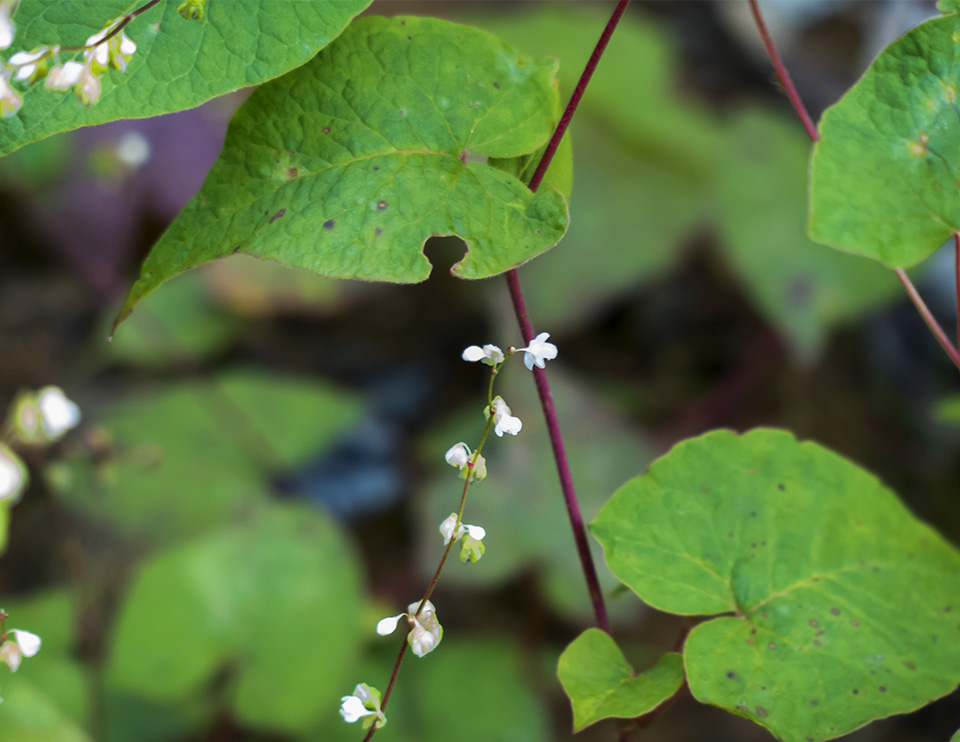
Plant composition on all seven plots changed in the intervening decade, even on the two control plots, suggesting that forests change even when there is no human-caused disturbance. The most obvious impact, evident in both the plant inventories and in casual observation of the sites, was the pronounced increase in American Red Raspberry and Allegheny Blackberry on the logged-over sites.
Sites with more intense forms of logging (clear cut, two age, and shelterwood) saw an increased abundance of certain plants, such as Fringed Black Bindweed, and decreasing numbers of others, such as Indian Cucumber-root and Canada Mayflower. Red Maple and Yellow Birch increased in abundance on most plots, which was not surprising since the harvest strategies were designed to favor these species. The frequency of American Beech and Black Cherry also increased.
Wildlife that flourishes in post-logging successional forests depends in part on how long the land has been left to recover. The wildlife profile for early successional hardwood or mixed wood forests (defined as those younger than a decade) includes many of those creatures found in old fields. Characteristic birds include the Ruffed Grouse, Chestnut-side Warbler, Nashville Warbler, Yellow Warbler, and Golden-winged Warbler. The latter species has become quite uncommon, due to loss of habitat, as early successional forests have given way to older forests.
Post-fire Recovery in the Adirondacks
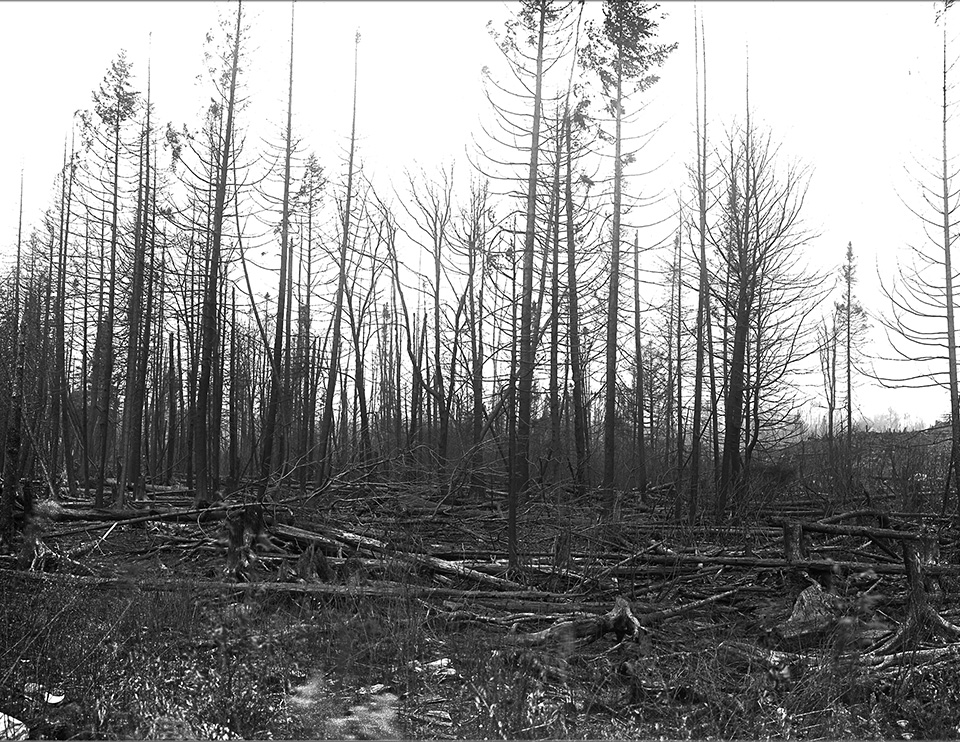
Large sections of the Adirondack forest (an estimated 850,000 acres or 14% of the land within the current boundaries of the Park) represent woodland that has grown up after a series of major fires that occurred in the late 19th and early 20th century. These fires came during a period of aggressive logging and an expansion of the rail system to serve the logging industry.
- Some of these fires were started by sparks from rail cars, others by careless hunters or farmers burning fallowing fields.
- The main factor responsible for the extent and intensity of the fires, according to most official reports at the time, was the drying slash left by loggers.
- The fires were particularly destructive in 1899, 1903, 1908, and 1913.
In 1899, 51,565 acres burned in what were referred to in official reports as "Adirondack counties." The largest areas affected were in Lewis County and St. Lawrence County. The fires occurred during a summer of unusual drought and were said to be caused by a wide variety of factors, including land clearing and railroad locomotives.
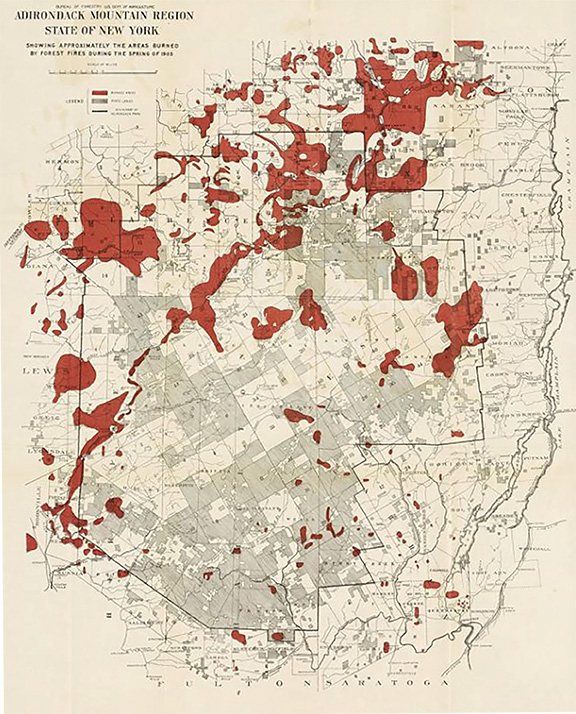
These fires were dwarfed by the "Great Fires of 1903," when a reported 643 fires in the Adirondack and Catskill regions burned 464,180 acres. In the Adirondacks, 428,180 acres (according to the New York State DEC) were affected. Sources do not make clear how many of these acres fell within the current boundaries of the Adirondack Park, but probably the vast majority of destroyed forest was within the Park.
In Lake Placid, about 14,000 acres were burned over, and almost every tree killed. Over 40,000 acres were devastated on the Rockefeller Preserve, near Paul Smiths. These were primarily spring fires, occurring between April 20th and June 8th. The fires were brought under control by the heavy, prolonged rains that began in June.
Five years later, in 1908, another destructive round of wildfires swept through the Adirondacks. New York State officials reported 643 fires in the Adirondack and Catskill regions, burning 368,082 acres. The fire at Long Lake West reportedly burned over 30,000 acres in a single day. Many of these fires were started by hunters or railroads and occurred in September and October, after a summer of dry weather.
The last year of major fires was 1913, when 54,796 acres burned in the Adirondack and Catskill regions. Most fire damage was in the Adirondacks, where (according to the DEC) 50,839 acres were affected. The fires, many of which were reportedly started by smokers, came during an intense summer drought.
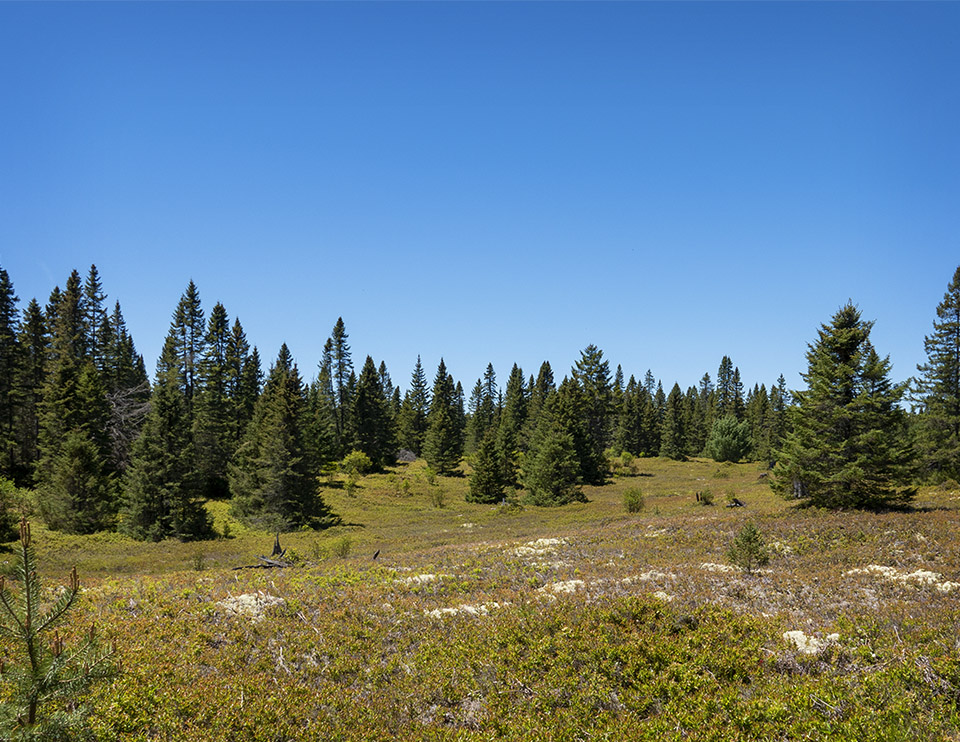
These fires had a longterm impact on forest dynamics in the Adirondacks. The forests regenerated, but shifted in composition away from a spruce-hemlock mix toward a forest in which hardwood plays a more dominant role.
- A 2004 study that compared second-growth Adirondack forests (recovering from early 20th century fires) and old-growth forests found a striking difference between old-growth forests (with canopies dominated by Eastern Hemlock) and post-fire forests (with canopies dominated by Sugar Maple and Paper Birch). Post-fire forests tend to be denser, with more small-diameter trees than stands with 350-year old trees.
- Other researchers have noted that the post-logging fires favored the Paper Birch over the Yellow Birch (the most common birch in pre-settlement Adirondack forests).
Forest Recovery After Weather Events
Major weather events have also shaped localized areas in Adirondack forests, which are (in some cases) still recovering.
- The Big Blow Down of 1950 was a powerful windstorm that occurred on 25 November 1950. An estimated 7% of the current Adirondack Park was heavily affected, with between 25 and 100 percent of the trees toppled. The storm left a confused jumble of fallen trees piled on top of one another. Spruce was among the most heavily damaged. The storm provoked a public debate on what to do with the fallen timber, since salvage of the fallen timber on state land ran counter to the "Forever Wild" provision in the New York State Constitution. Salvage operations were eventually approved after vigorous debate, during which proponents argued that salvaging the timber would reduce the fire danger.
- The Blow Down of 15 July 1995 was a fast-moving line of intense storms. According to DEC estimates based on satellite imagery, 38,000 acres of forest were severely damaged and 109,000 acres were moderately damaged. The most severe forest damage started just west of Five Ponds Wilderness and extended southeast. In this case, state authorities decided against salvage operations on state lands. The forest regenerated relatively quickly. The area began to green up with grasses and other herbaceous plants the first full growing season after the storm. Within a decade, vigorous crops of seedlings were filling in the gaps created by the storm, mainly sun-loving species such as aspen, Eastern White Pine, Yellow Birch and Black Cherry. After twenty years, the fastest growing trees had reached fifteen to thirty feet tall, shading out the slower growing varieties.
- The January 1998 ice storm lasted three days, coating trees and power lines with a thick layer of ice. Tree crowns were partially or totally lost as stems snapped and branches broke with the weight of the deposited ice. The storm affected 4.6 million acres of forest in New York State. The impact to forests varied greatly. Softwoods were less affected than hardwoods. Among hardwoods, birch was particularly hard hit. Studies done 15 years after the storm revealed high survival rates for Sugar Maple and Red Maple, but much lower survival for Yellow Birch and Paper Birch. For instance, less than a quarter of Paper Birch with crown loss of over half had survived by 2012.
References
E. H. Ketchledge. Forests and Trees of the Adirondack High Peaks Region (Adirondack Mountain Club, 1967), pp. 18-43, 96-101, 107-108, 129-131.
Michael Kudish. Adirondack Upland Flora: An Ecological Perspective (Saranac, New York: The Chauncy Press, 1992).
John Kricher. A Field Guide to Eastern Forests. North America (Boston: Houghton Mifflin, 1998), pp. 154-219.
Peter J. Marchand. Nature Guide to the Northern Forest. Exploring the Ecology of the Forests of New York, New Hampshire, Vermont, and Maine (Appalachian Mountain Club, 2010), pp. 13-18, 56-93.
Donald J. Leopold and Lytton John Musselman. Wildflowers of the Adirondacks (Johns Hopkins University Press, 2020), pp. 39-44.
Alan E. Bessette et al. Birds of the Adirondacks: A Field Guide (Utica, New York: North Country Books, 1993).
James M. Ryan. Adirondack Wildlife: A Field Guide (University of New Hampshire Press, 2008), pp. 13-42.
D. Andrew Saunders. Adirondack Mammals (Adirondack Wildlife Program. State University of New York College of Environmental Sciences and Forestry, 1995).
William K. Chapman. Mammals of the Adirondacks: A Field Guide (Utica, New York: North Country Books, 1991).
William K. Chapman and Alan E. Bessette. Trees and Shrubs of the Adirondacks: A Field Guide (Utica, New York: North Country Books, 1990).
Charles D. Canham, "Upland Forests of the Adirondacks. Reflections of Soils and a Record of Disturbance," William F. Porter, Jon D. Erickson and Ross S. Whaley. The Great Experiment in Conservation. Voices from the Adirondack Park (Syracuse University Press, 2009), pp. 60-70.
William F. Porter, "Forestry in the Adirondacks: An Economy Built on a Handful of Species," William F. Porter, Jon D. Erickson and Ross S. Whaley. The Great Experiment in Conservation. Voices from the Adirondack Park (Syracuse University Press, 2009), pp. 102-113.
Gary Wade et al. Vascular Plant Species of the Forest Ecology Research and Demonstration Area, Paul Smiths, New York. USDA Forest Service. Research Note NE-380. Retrieved 22 January 2017.
Mark J. Twery, et al. Changes in Abundance of Vascular Plants under Varying Silvicultural Systems at the Forest Ecosystem Research and Demonstration Area, Paul Smiths, New York. USDA Forest Service. Research Note NRS-169. Retrieved 22 January 2017.
Katherine Yard and Elizabeth Cooper. Young Forest Initiative Monitoring Plan. 2016 - 2025 (NYS Department of Environmental Conservation, 22 April 2016), Appendix A. Young Forest Wildlife, pp. 20-27. Retrieved 10 January 2019.
Jeffrey S. Ward. Northeastern Forest Regeneration Handbook: A Guide for Forest Owners, Harvesting Practitioners, and Public Officials. USDA Forest Service. NA–TP–03–06 July 2006. Retrieved 18 January 2017.
Ellen Rathbone, "Pin Cherry: An Overlooked Adirondack Native," Adirondack Almanack, 12 May 2010. Retrieved 13 January 2017.
Paul Hetzler, "In Adirondack Forests, Trees Age Differently," Adirondack Almanack, 7 March 2016. Retrieved 13 January 2017.
New York State. Adirondack Park Agency. Natural Communities of the Adirondack Park. Retrieved 13 January 2017.
New York State Department of Environmental Conservation. New York Natural Heritage Program. Ecological Communities of New York State. Second Edition (March 2014). Retrieved 17 January 2017.
New York State. Department of Environmental Conservation. Strategic Plan for State Forest Management. 2011. Chapter 2, pp. 46-52. Retrieved 27 January 2017.
New York State. Adirondack Park Agency. 1916 Fire Protection Areas of the Adirondack Park. Retrieved 27 January 2017.
Susy Svatek Ziegler, "Postfire Succession in an Adirondack Forest," Geographical Review, Vol. 97, No. 4 (Oct., 2007), pp. 467-483.
Susy Svatek Ziegler, "Composition, Structure, and Disturbance History of Old-growth and Second-growth Forests in Adirondack Park, New York," Physical Geography, Volume 25, Issue 2, 2004, pp. 152-169. Retrieved 26 January 2017.
Annual report of the Commissioners of Fisheries, Game and Forests of the State of New York. New York (State). Commissioners of Fisheries, Game and Forests. 1898-1899. Retrieved 26 January 2017.
William Gibbs Howard. Forest Fires. State of New York Conservation Commission Bulletin 10. 1 January 1914. Retrieved 25 January 2017.
Herman Suter. Forest Fires in the Adirondacks in 1903 (United States. Bureau of Forestry, 1904) Retrieved 25 January 2017.
"Rockefeller a Fireman," The Johnstown Daily Republican, 20 May 1903, p 1. Retrieved 6 December 2019.
"Forest Fires Raging. Many Place in the Adirondacks Threatened," Ithaca Daily Journal, 1 May 1903, p. 8. Retrieved 6 December 2019.
"Adirondack Forest Fires," The Elizabethtown Post, 24 August 1899, p. 1. Retrieved 6 December 2019.
"Fires in Adirondacks," The Evening Post, 23 September 1908, p. 2. Retrieved 6 December 2019New York State Department of Environmental Conservation, Wildland Fires & Acres Burned in New York State. Retrieved 26 January 2017.
New York State Department of Environmental Conservation. Fire Tower Study for the Adirondack Park (February 2010), pp. 43- 47. Retrieved 25 January 2017.
Jerry Jenkins. Notes on the Adirondack Blowdown of July 15th, 1995: Scientific Background, Observations, and Policy Issues. Wildlife Conservation Society, 1995.
Michael R. Bridgen. Effects of the 1995 Microburst storm upon the structure, development and regeneration of Adirondack forests. 4 September 1996.
Dave Smith, "The '95 Blowdown: Then and Now," New York State Conservationist, August 2015, pp. 12-15. Retrieved 28 January 2017.
Walter C. Shortle et al. Tree Survival and Growth Following Ice Storm Injury. USDA Forest Service. Northeastern Research Station Research Paper NE-723. May 2003. Retrieved 13 January 2017.
Walter C. Shortle et al. Tree Survival 15 Years after the Ice Storm of January 1998. USDA Forest Service. Northern Research Station. Research Paper NRS-25. February 2014. Retrieved 28 January 2017.
Janet Essman, "Ice Storm: Nature Adapts," New York State Conservationist, Volume 53, Number 3 (December 1998), pp. 2-7.
Kevin T. Smith, et al. Patterns of Storm Injury and Tree Response. USDA Forest Service. Northeastern Research Station. NA-TP-02-01. Retrieved 28 January 2017.
New York State Forest Resource Assessment and Strategy: 2010 – 2015 Keeping New York’s Forests as Forests (New York State. Department of Environmental Conservation, 2010), pp. 24-30.
Margaret Miller-Weeks and Chris Eagar. The Northeastern Ice Storm 1998: A Forest Damage Assessment. (USDA Forest Service, 1999). Retrieved 13 January 2017.
John Warren, "The Big Blowdown of 1950," Adirondack Almanack, 15 November 2010. Retrieved 13 January 2017.
John Warren, "Anniversary of The Great Adirondack Blowdown of 1995," Adirondack Almanack, 15 July 2009. Retrieved 13 January 2017.
Tom Pasquarello and Steve Broyles, "Forever Wild and the Great Blowdown of '95: Part 1," Wilderness and Waterslides, 15 July 2008. Retrieved 27 January 2017.
Tom Pasquarello and Steve Broyles, " Blow Down Natural History Part 2," Wilderness and Waterslides, 23 September 2008. Retrieved 27 January 2017.
Joe Rankin, "How Ice Storms Impact Trees," Adirondack Almanack, 13 January 2015.
Ellen Rathbone, "Bluebirds in the Adirondacks," Adirondack Almanack, 8 May 2010. Retrieved 24 January 2017.
George Robinson and Jeffrey Zappieri, "Conservation policy in time and space: lessons from divergent approaches to salvage logging on public lands," Conservation Ecology. Volume 3, Issue 1. 1999. Retrieved 13 January 2017.
C. W. Severinghaus and C. P. Brown, "The White-tailed Deer in New York," New York Fish and Game Journal, July 1956. Retrieved 24 January 2017.
Meghan Gilbart. Under Cover: Wildlife of Shrublands and Young Forest (Wildlife Management Institute, January 2012). Retrieved 10 January 2019.
S.M. Treyger and M.F. Burger. Forest Management for New York Birds: A Forester’s Guide (Audubon New York, 2017). Retrieved 10 January 2019.
